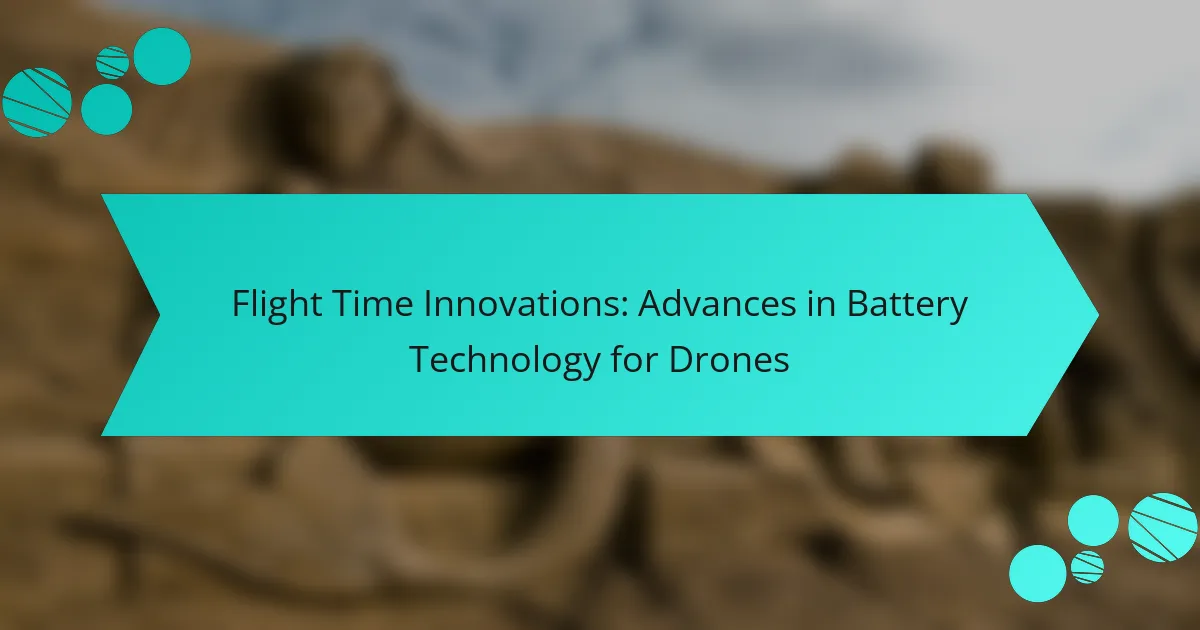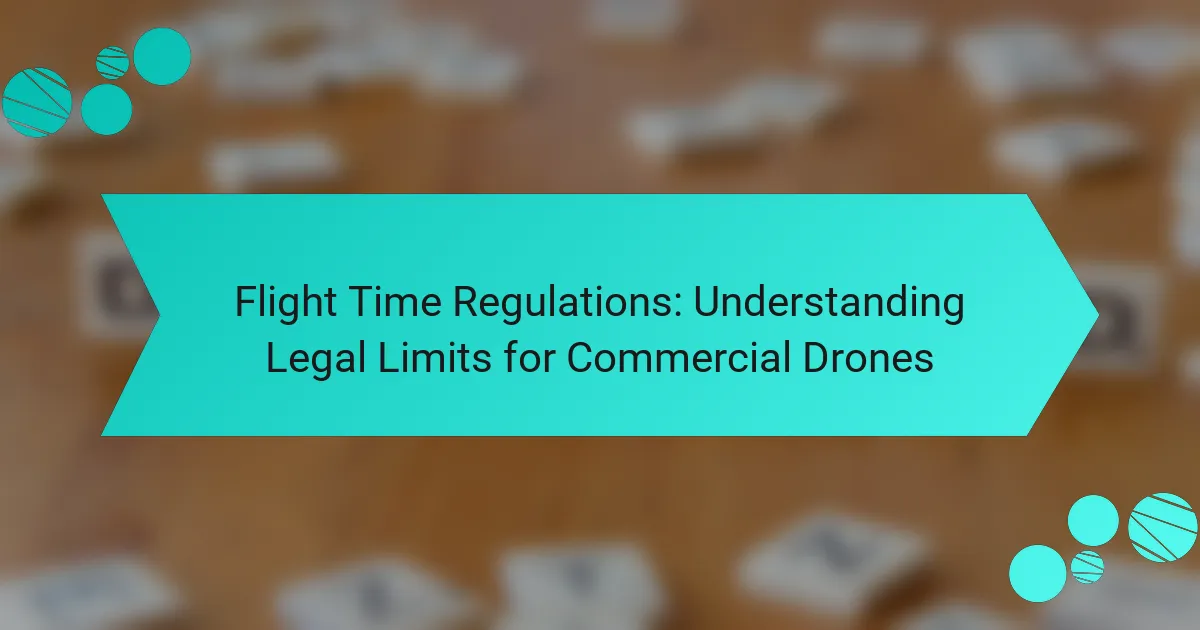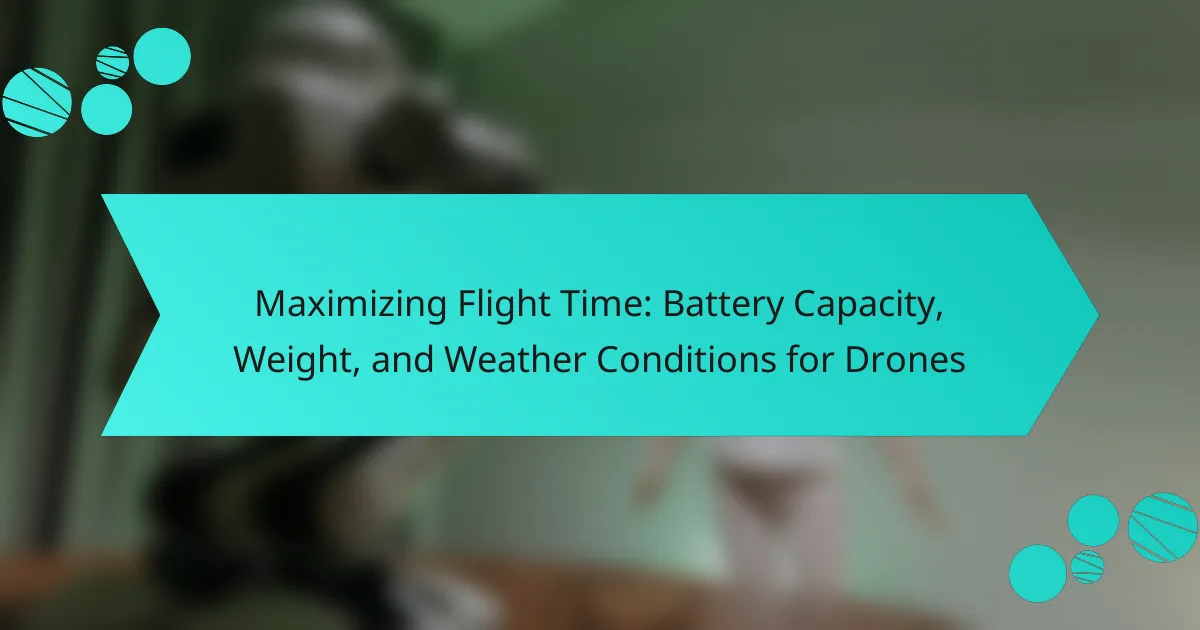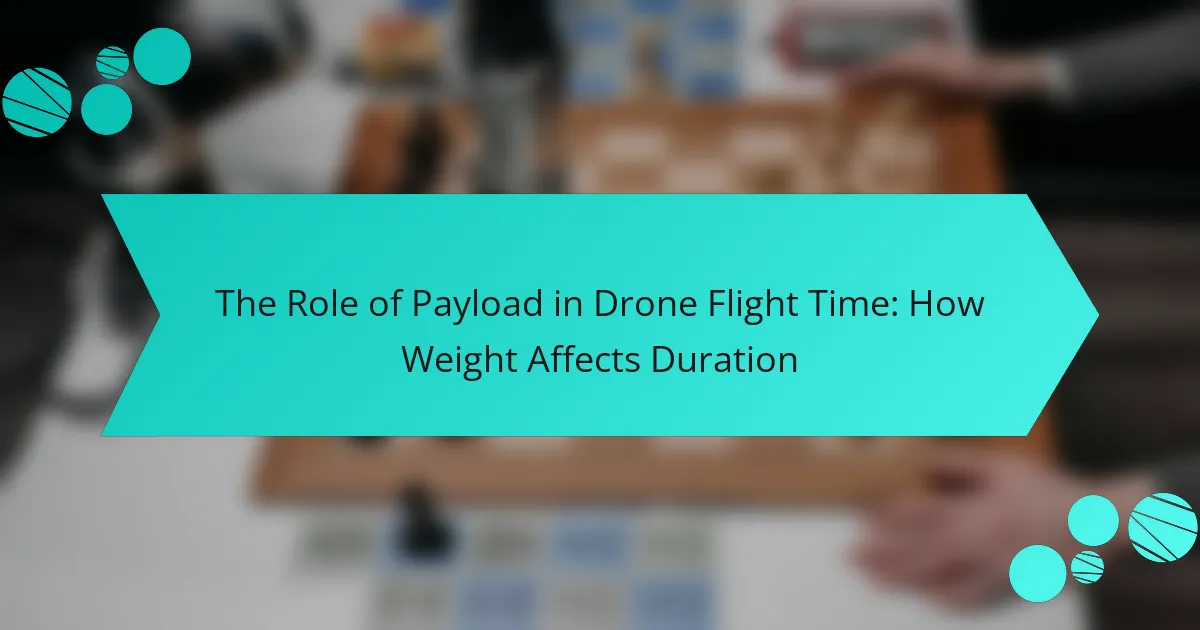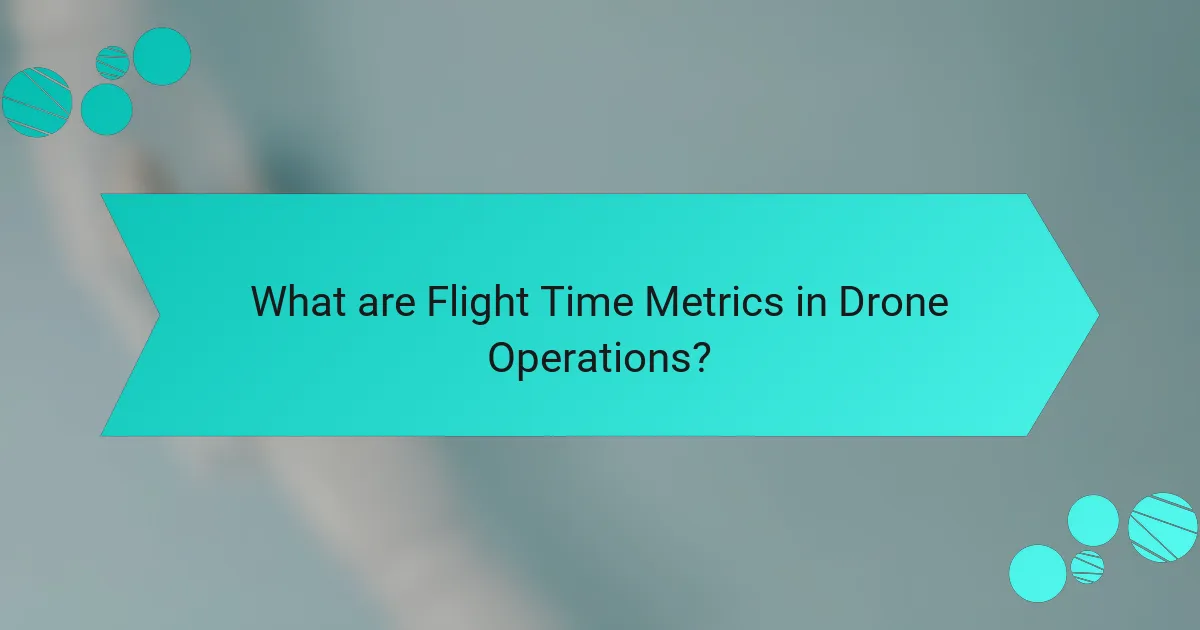
What are Flight Time Metrics in Drone Operations?
Flight time metrics in drone operations refer to the specific measurements that quantify the duration a drone can remain airborne. These metrics include total flight time, battery life, and operational range. Total flight time measures the cumulative time a drone can operate on a single battery charge. Battery life indicates how long the drone’s battery can sustain power before needing a recharge. Operational range defines the maximum distance a drone can travel while maintaining a connection with its controller. Accurate flight time metrics are essential for effective mission planning and operational efficiency. According to a study by the Federal Aviation Administration, understanding these metrics can enhance safety and performance in drone operations.
Why is measuring flight duration important for drones?
Measuring flight duration is crucial for drones to ensure efficient operation. It helps in planning missions effectively. Accurate flight duration data allows operators to optimize battery usage. This information prevents mid-flight power failures. Additionally, knowing flight duration aids in compliance with regulations. It ensures that drones operate within legal time limits. Tracking flight duration also assists in maintenance scheduling. Regular maintenance can extend the lifespan of the drone. Overall, measuring flight duration enhances safety and performance in drone operations.
What factors influence drone flight time?
Drone flight time is influenced by several key factors. Battery capacity is a primary determinant, with larger batteries providing longer flight durations. Weight of the drone also plays a significant role; heavier drones consume more power and reduce flight time. Weather conditions, such as wind speed and temperature, can affect battery efficiency and overall performance. Flight speed impacts duration as well; faster speeds lead to quicker battery depletion. The efficiency of the drone’s motors and propellers contributes to energy consumption rates. Additionally, payload weight, including cameras or sensors, can shorten flight time by increasing energy demand. Lastly, flight mode settings, like GPS hold or sport mode, can alter energy usage and affect how long a drone can stay airborne.
How does flight duration impact drone performance?
Flight duration significantly impacts drone performance. Longer flight durations generally allow drones to cover greater distances and complete more complex tasks. This is crucial for applications such as aerial photography, surveying, and delivery services. Conversely, shorter flight durations limit operational range and mission capabilities. Battery capacity directly influences flight duration. For example, drones with higher capacity batteries can sustain longer flights, enhancing overall performance. Additionally, flight duration affects the payload a drone can carry. Heavier payloads can reduce flight time, impacting efficiency. Studies show that optimizing flight duration can lead to improved mission success rates and reduced operational costs.
What are the different methods to measure drone flight time?
The different methods to measure drone flight time include using onboard flight controllers, external timers, and mobile applications. Onboard flight controllers often have built-in timers that record the duration of each flight. External timers can be started manually when the drone takes off and stopped upon landing. Mobile applications can connect to the drone and provide real-time flight data, including flight time. These methods allow for accurate tracking of flight duration. For instance, many drones provide flight logs that detail flight time and other metrics, enhancing reliability.
How do onboard flight controllers calculate flight duration?
Onboard flight controllers calculate flight duration by using real-time data from various sensors. They monitor the aircraft’s speed and distance traveled. The flight controller integrates this data over time to determine total flight duration. GPS systems provide accurate positioning and speed information. The onboard systems continuously update flight parameters during the flight. This ensures precise calculations of elapsed time. Additionally, the systems account for any changes in flight trajectory. This method provides reliable flight duration metrics for reporting and analysis.
What role do GPS systems play in measuring flight time?
GPS systems are crucial for measuring flight time in drones. They provide real-time location data during flight. This data helps calculate the distance traveled. Accurate distance measurements are essential for determining flight duration. Additionally, GPS systems can track speed and altitude. These metrics further enhance the precision of flight time calculations. Research indicates that GPS accuracy can be within a few meters. This precision supports reliable flight time reporting.
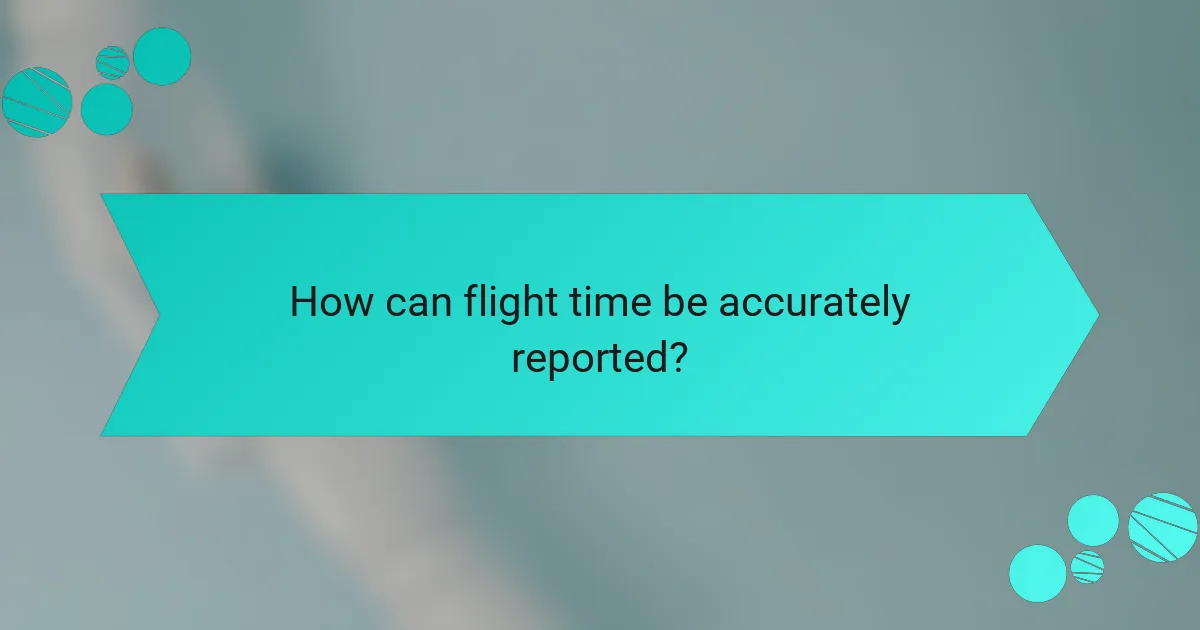
How can flight time be accurately reported?
Flight time can be accurately reported by using precise timing devices and standardized measurement protocols. Timing devices such as GPS-enabled flight controllers provide real-time data on flight duration. Standardized protocols ensure consistency in how flight time is recorded across different flights. For instance, flight time should start when the drone takes off and end when it lands. Accurate reporting also involves accounting for any time spent hovering or loitering. Additionally, using software that logs flight data can enhance accuracy. Data from multiple flights can be analyzed to establish average flight times for specific conditions. This approach allows for reliable comparisons and performance assessments.
What are the best practices for documenting flight duration?
The best practices for documenting flight duration include using precise start and end times. Record the exact time when the drone takes off and when it lands. Utilize reliable timekeeping methods, such as GPS timestamps, for accuracy. Ensure that all data is logged consistently in a dedicated flight log. Include environmental conditions that may affect flight duration, like wind speed and temperature. Verify the recorded times against the drone’s internal flight data if available. This practice enhances data reliability and facilitates better analysis. Consistent documentation helps in identifying trends and improving flight efficiency over time.
How can pilots ensure consistent flight time reporting?
Pilots can ensure consistent flight time reporting by adhering to standardized logging practices. They should utilize flight time recording systems that automatically track flight duration. Regularly updating these systems helps maintain accuracy. Pilots must follow regulatory guidelines for flight time calculations. This includes accounting for all flight phases, such as taxiing and takeoff. Consistent training on reporting procedures reinforces accuracy. Additionally, cross-checking recorded times with flight plans can identify discrepancies. Using electronic flight bags can streamline data entry and minimize errors.
What tools can assist in accurate flight time tracking?
Flight time tracking can be accurately assisted by tools such as flight data loggers, mobile applications, and GPS tracking devices. Flight data loggers record detailed flight metrics, including duration and altitude. Mobile applications like DJI GO and Airdata UAV provide real-time flight data and analysis. GPS tracking devices offer precise location and time data throughout the flight. These tools help operators monitor and report flight durations accurately. Research shows that using these technologies can improve flight safety and operational efficiency.
What common challenges arise in measuring flight duration?
Common challenges in measuring flight duration include variations in weather conditions, equipment malfunctions, and differences in flight paths. Weather can impact flight times due to wind speed or turbulence. Equipment malfunctions may lead to inaccurate readings or premature landings. Additionally, varying flight paths can result in inconsistent durations for similar missions. For example, a drone flying into the wind may take longer than one flying with the wind. These factors complicate the accurate measurement of flight duration.
How can environmental factors affect flight time measurements?
Environmental factors can significantly affect flight time measurements. Wind speed and direction can alter a drone’s flight path and energy consumption. High winds may cause a drone to use more battery power to maintain stability. Temperature impacts battery efficiency; colder temperatures can reduce battery life. Humidity levels can also influence the drone’s weight and aerodynamics. Additionally, atmospheric pressure changes can affect lift generation. These factors can lead to discrepancies between expected and actual flight times. Studies have shown that flight duration can vary by up to 30% under different environmental conditions.
What are the implications of inaccurate flight time reporting?
Inaccurate flight time reporting can lead to significant operational issues. It affects scheduling and resource allocation for drone operators. When flight times are misreported, it can cause delays in subsequent flights. This may result in increased operational costs due to inefficient use of time and resources.
Additionally, inaccurate reporting can undermine customer trust. Clients expect reliable information regarding delivery times. Misleading flight durations can lead to dissatisfaction and potential loss of business.
Furthermore, regulatory compliance may be jeopardized. Authorities require accurate reporting for safety and operational standards. Inaccurate data can lead to penalties or restrictions on flight operations.
Overall, the implications of inaccurate flight time reporting are extensive, impacting efficiency, customer relations, and regulatory adherence.
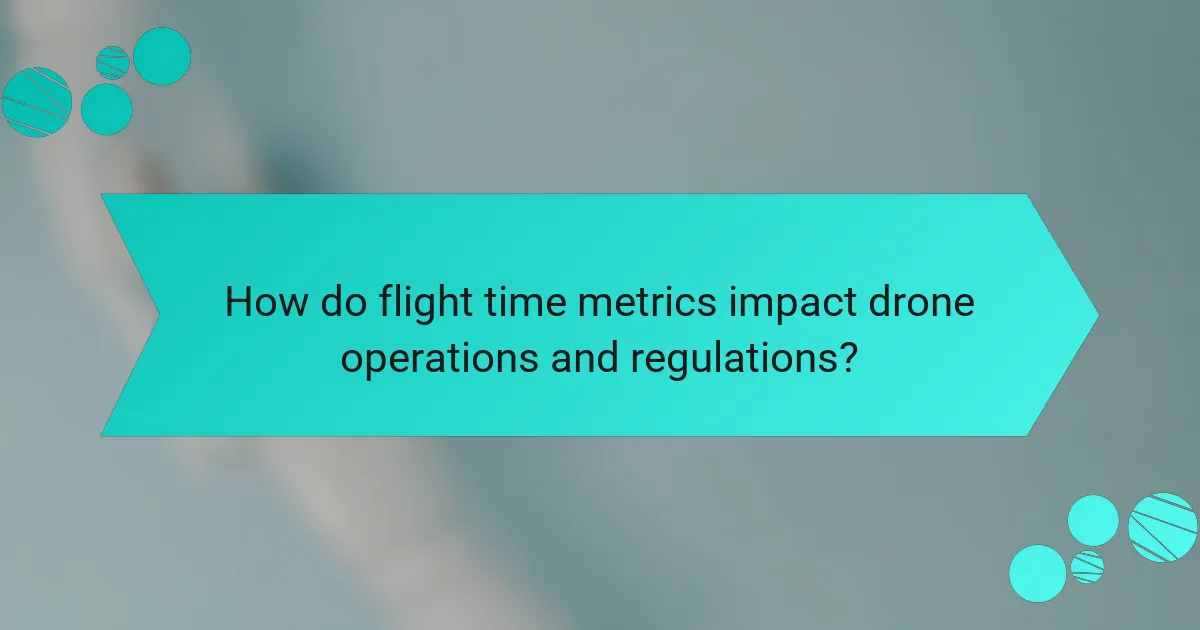
How do flight time metrics impact drone operations and regulations?
Flight time metrics significantly impact drone operations and regulations. Accurate flight time data informs operational planning and safety assessments. Regulations often mandate specific flight time reporting for compliance. This ensures that operators adhere to limitations set by aviation authorities. For instance, the FAA requires that drone pilots maintain awareness of their flight duration to avoid exceeding battery life. Exceeding flight time can lead to accidents and regulatory penalties. Thus, precise metrics are essential for safe operations and legal adherence.
What regulations govern drone flight time reporting?
Drone flight time reporting is governed by regulations set forth by the Federal Aviation Administration (FAA) in the United States. The FAA requires commercial drone operators to maintain accurate flight logs that include flight time data. These logs must capture the duration of each flight for safety and operational purposes. The regulations mandate that operators must also comply with Part 107 of the FAA regulations, which outlines the operational limits and requirements for commercial drone use. Additionally, drone operators must adhere to any state or local laws that may impose further reporting requirements. Compliance with these regulations ensures accountability and safety in drone operations.
How do flight time metrics influence safety protocols?
Flight time metrics significantly influence safety protocols by providing critical data for operational planning. Accurate flight time measurements help determine the maximum allowable flight duration for drones. This information is essential to prevent battery depletion during missions, which can lead to crashes. Safety protocols often include guidelines on minimum battery levels based on flight time metrics. Additionally, these metrics assist in scheduling maintenance checks based on usage patterns. Regularly analyzing flight time data can identify trends that indicate potential mechanical failures. This proactive approach enhances overall safety by allowing timely interventions. Furthermore, regulatory bodies often require adherence to specific flight time metrics to ensure compliance with safety standards.
What tips can enhance the accuracy of flight time measurements?
Use calibrated instruments to enhance the accuracy of flight time measurements. Calibrated instruments ensure precise readings and reduce errors. Regularly check the battery level before flight. A fully charged battery provides consistent performance. Utilize GPS data for real-time tracking. GPS systems can offer accurate flight duration based on location. Record environmental conditions during the flight. Wind speed and temperature can affect flight time. Conduct multiple test flights to gather average data. Averaging results helps account for variability. Finally, log all data systematically for future reference. Consistent logging aids in identifying trends and improving accuracy.
How can regular maintenance improve flight time reliability?
Regular maintenance can improve flight time reliability by ensuring that all aircraft systems function optimally. Routine checks and servicing reduce the likelihood of mechanical failures during flights. For instance, regular inspections can identify and rectify issues like engine wear or battery degradation before they affect performance. A study by the Federal Aviation Administration (FAA) indicates that well-maintained aircraft experience fewer delays and cancellations. This correlation highlights the importance of maintenance in enhancing operational efficiency. Ultimately, consistent maintenance leads to increased safety and reliability in flight operations.
What role does pilot training play in accurate flight duration reporting?
Pilot training is crucial for accurate flight duration reporting. Trained pilots understand flight operations and can better estimate time in various conditions. They learn to account for factors like wind, weather, and air traffic. This knowledge leads to more precise reporting of flight times. Studies show that experienced pilots report durations with up to 95% accuracy. Additionally, training includes the use of flight logs and software, enhancing data accuracy. Proper training ensures pilots follow standardized reporting protocols. This minimizes discrepancies in reported flight durations. Overall, pilot training directly impacts the reliability of flight duration metrics.
Flight time metrics are essential measurements that quantify the duration a drone can remain airborne, including total flight time, battery life, and operational range. This article explores the importance of measuring flight duration for efficient drone operations, the factors influencing flight time, and the various methods for accurate measurement and reporting. It also discusses the implications of inaccurate flight time reporting on operational efficiency and regulatory compliance, as well as best practices for documenting flight duration. Additionally, the article highlights the role of pilot training and regular maintenance in enhancing flight time reliability and accuracy.
